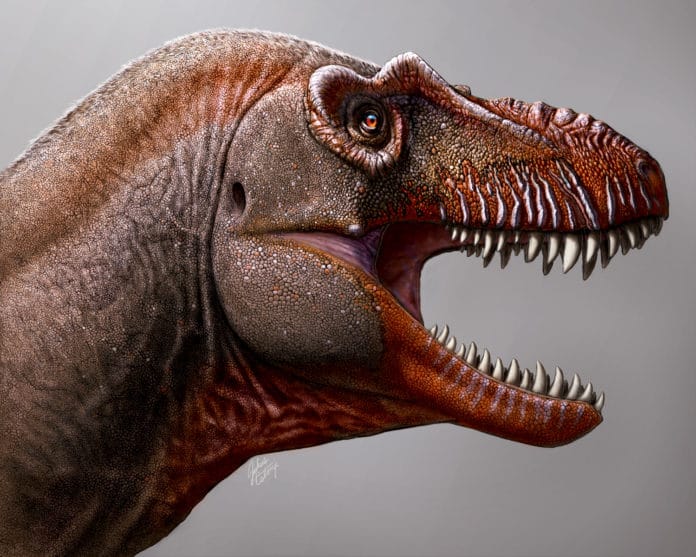Paleontologists have discovered a new species of a tyrannosaur in southern Alberta, Canada. Thanatotheristes Degrootorum is one of the oldest tyrannosaur species ever discovered in North America, according to an article published by researchers from the University of Calgary and the Royal Tyrrell Museum of Palaeontology in the journal Cretaceous Research. At roughly 79.5 million years old, this species is 2.5 million years older than its closest relative and is directly linked to Tyrannosaurus rex.
“Alberta has a rich dinosaur history, and we have uncovered some of the biggest finds on Earth here in the province,” said Dr. François Therrien, Curator of Dinosaur Palaeoecology at the Royal Tyrrell Museum. “The discovery of Thanatotheristes Degrootorum is historic as it marks the first new species of tyrannosaur to be unearthed in Canada in 50 years. The last tyrannosaur described from Canada was Daspletosaurus in 1970.”
Tyrannosaurs were a group of large predatory theropod dinosaurs (bipedal meat-eaters). This species of tyrannosaur was eight to nine meters (26.2 to 30 feet) long and weighed approximately two tonnes as a full-grown adult. In comparison, a full-grown Tyrannosaurus rex could reach 12 meters (39.3 feet) in length. There are only four other tyrannosaurs known from Canada: Daspletosaurus, Gorgosaurus, Albertosaurus, and Tyrannosaurus.
Scientists were able to identify this as a new species by analyzing the unique features of fossil skull fragments. “Thanatotheristes can be distinguished from all other tyrannosaurs by numerous characteristics of the skull, but the most prominent are vertical ridges that run the length of the upper jaw,” said Jared Voris, a University of Calgary Ph.D. candidate, and lead author of the study.
In addition to representing a new species, a detailed analysis of the specimen reveals that various groups of tyrannosaurs, each with their own “morphotype,” or body plan, populated different parts of North America during the Campanian (Late Cretaceous, 80 – 74 million years ago): primitive tyrannosaur lived in the southern U.S; long-legged, lightly-built tyrannosaur (i.e. Albertosaurinae) lived in central Alberta; and a new clade of robust, long-snouted tyrannosaurs to which Thanatotheristes belonged lived in between, in southern Alberta and Montana.
Most dinosaur species from Alberta date from between 77 – 66 million years old. There are only two other dinosaurs known from Alberta from the same time period as Thanatotheristes: a dome-headed dinosaur (Colepiocephale) and a horned dinosaur (Xenoceratops).
The name of the new tyrannosaur alluded to its role as an apex predator and was inspired by Thanatos (Greek god of death) and Theristes (one who reaps or harvests). The second part of the name honours the De Groot family.
John De Groot, a farmer and paleontology enthusiast, found the fossil skull fragments while hiking near Hays, Alberta. John and Sandra De Groot have been valuable supporters of palaeontological fieldwork in southern Alberta.
“The jawbone was an absolutely stunning find. We knew it was special because you could clearly see the fossilized teeth,” said De Groot.
“This discovery is significant because it fills in a gap in our understanding of tyrannosaur evolution,” said Dr. Therrien. Thanatotheristes provides scientists with insights into the tyrannosaur family tree and shows that tyrannosaurs from the Cretaceous of Alberta were more diverse than previously known.
